Leadership & Management
A Structural Perspective
The following is an elaboration of an idea which has been kicking
around for quite some time and I just wanted to get it roughed
out so I didn't lose it. The idea has to do with a perception
that management is essential a push operation while leadership
is a pull operation. As I try to think about where the concept
originated it seems to be something which emerged from DePree
(1989). Although there were many things things about this work
which were memorable there were two particular ones that have
stuck very profoundly.
- The first responsibility of a leader is to define reality.
The last responsibility is to say, "thank you." In
between the leader should be a servant.
- One should think of a leader as a bus driver. If you don't
take people where they want to go they get off the bus.
As I thought about the traditional definition of management
as, planning, organizing, directing, and controlling, in conjunction
with hierarchical structure it seemed there was a characteristic
result associated with the structure I had not previously considered
or seen described.
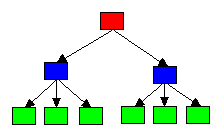
Organizations generally tend to pursue objectives of one type
or another. From this I decided to view the structure rotated
90 degrees with a management implication.
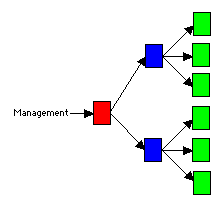
Now this part may be a bit difficult but imagine this structure
made out of toothpicks and gumdrops. And as the management emphasis
is applied the structure has a natural tendency to fan out.
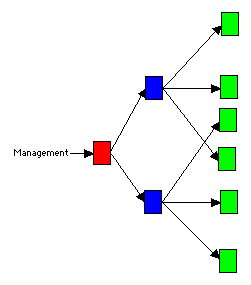
As a result of this fan out the organization will have a tendency
to be less focused on its objective(s) and less effective in achieving
them. As a result of this management effort is not simply applied
from the perspective previously indicated. Management effort is
applied in from numerous perspectives simply attempting to keep
the organization focused on the objective. This management effort
is essentially to compensate for the natural fan out tendency
of the structure.
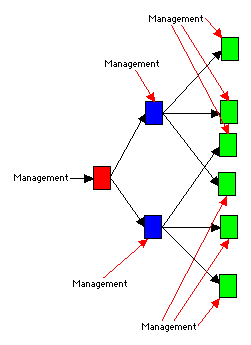
It should be readily apparent that all compensating effort
is essentially added overhead to the organizational operation.
Wouldn't it be nice if one didn't have to expend all this additional
effort to keep the organization focused on its objective(s).
Think about this structure again made out of toothpicks and gumdrops
consider what happens when you turn it around and pull on it,
rather than push on it. The natural tendency is for the structure
to attempt to come into alignment focused on the direction of
the leadership.
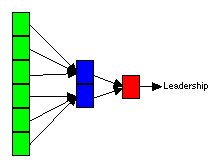
Now it would appear that I have lead you down a path to consider
leadership and management as mutually exclusive alternatives.

Yet, consider the possibility if the paradigm were changed
to consider the pursuit of leadership and management in an integrated
fashion.
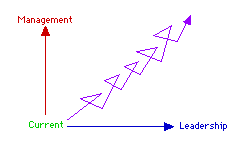
This might be doable if we were to alter the perception of
the role of management. If management were a supportive function
rather than a directive function the diagram might look somewhat
like the following. In this context is seems that management would
be a service providing function offering training, development,
coaching, mentoring, and the like, rather than performing the
traditional planning, organizing, directing and controlling functions.
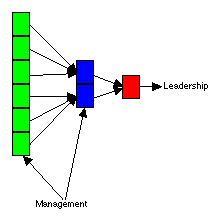
Just a set of thoughts I didn't want to lose. Your comments
are most welcome.
theWay of Systems
* Feedback
* Musings
Copyright © 2004 Gene Bellinger
|